This past weekend, a birding acquaintance of mine from Florida came up to Duluth to celebrate what I’ve long called Superb Owl Sunday. He arrived on Friday afternoon, and we birded steadily during daylight hours until he left on Monday afternoon. He added three lifer owls—Snowy Owl on Friday at the Superior Airport, Great Gray Owl on Saturday in the Sax-Zim Bog, and Northern Hawk Owl on Sunday on Jean Duluth Road north of Duluth, so both Superb Owl Sunday and the rest of the weekend lived up to the hype. We also saw lots of other northern birds that were new for him. So all in all it was a wonderfully successful weekend.
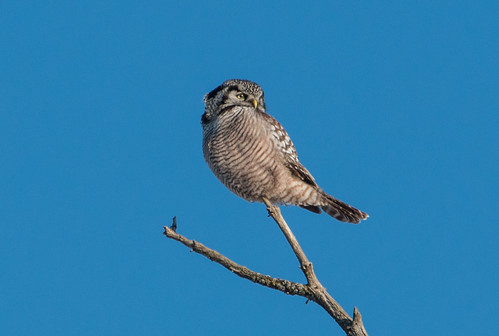 |
| Superb Owl Sunday Northern Hawk Owl |
But it was also an exhausting one. I put over 700 miles on my car, making it expensive and energy-intensive as well—much more than if I were covering the same area on my own, not feeling like I had to go back repeatedly to spots where we missed a single “target bird.”
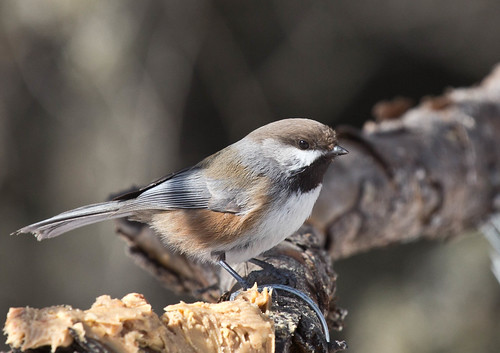 |
| Boreal Chickadee: One of the target birds we got skunked on |
Maybe that sense of
targets is the trick for me. I have a genuine antipathy for wasting fuel, so I don’t bird far from home without serious thought about the energy costs, but I do love occasionally getting up early and setting out for the bog, or for the Superior National Forest along Highways 2 and 1 north of Two Harbors, in hopes of seeing cool birds. It’s fun to be open to all the possibilities without specific goals, and my birding virtually never holds any disappointments—heck, even when I went to Quincy, Illinois on a failed effort to see an Ivory Gull, my lasting memory is more of what a fun experience that was than of disappointment.
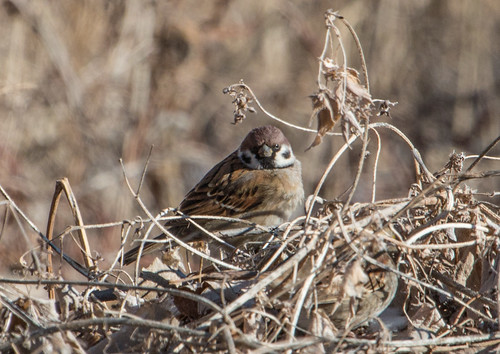 |
My first Illinois Eurasian Tree Sparrow--bonus bird when I was in Quincy, Illinois.
You win some, and you lose some. |
When I do come upon something interesting, which may be something as universally thrilling as a Great Gray Owl or as simple as a chickadee taking a sample bite out of a shrike’s cached mouse impaled on a thorn, I don’t enjoy jumping back in the car to move on to the next target. If I really want to see a specific bird that is supposed to be in one area, I prefer staying there as long as possible, enjoying everything else there in the interim, to moving on and coming back repeatedly so I can get a whole panoply of “target birds.”
When it comes down to it, I’m a moseyer. Like any other birder, I love having as long a list of species as possible for a given jaunt, and measure my skills by the birds I pick out by sight and sound. When I started birding, before I'd brought my life list to over 600 for the Lower 48, I was pretty intent on that milestone, but even when I was most acquisitive, except on specific "Big Days," I've never enjoyed birding just to have a long list of species.
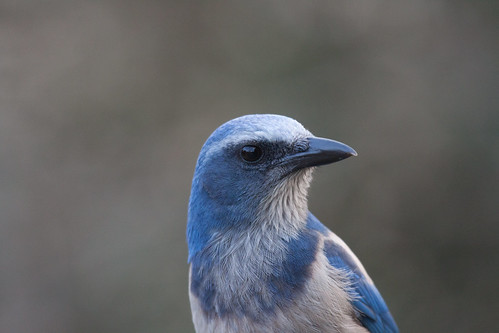 |
| The Florida Scrub-Jay was #600 on my life list. I saw my first, with my whole family, in 1999, at Lake Kissimmee State Park. My kids and Russ were all charmed by these friendly birds--the PERFECT milestone species for meeting my ultimate birding goal of 600 species in the Lower 48. |
Looking back on most birding jaunts, I remember specific cool experiences with individual birds and other critters far more than the final number. And I especially don’t like feeling responsible for what other people see. I do enjoy leading birding field trips—those experiences helped improve my own birding skills when I was starting out, and I love sharing my knowledge of places and birds with others. But leading field trips never feels anywhere near as intense as showing someone who has come a long way all the birds that person "needs” to see to make the trip worthwhile.
When I was amassing my own life list and Russ and I took trips to new places, I loved exploring on my own. We covered all the best spots in Florida, southeastern Arizona, the Rio Grande Valley of Texas, Florida, and California following instructions in birding books and checking out spots that looked interesting or just happened to be near where Russ had to be for something else, as well as the spots pinpointed in the birding books. The pleasures came from getting a feel for different habitats and how to find different birds in new places entirely on my own.
Even when I did my Big Year, when part of the whole point was to amass a big list, I did most of the birding by myself—somehow birds feel more earned and “mine” that way. I did have some special target birds for which I spent an inordinate amount of time searching, like the Colima Warbler for which I hiked twelve miles, alone in the rain, in Big Bend National Park, and the Hermit Warbler for which I went to San Lorenzo Park in Santa Cruz, California, three times before I finally got the bird--though each time I went there, I had plenty of other wonderful experiences, as well.
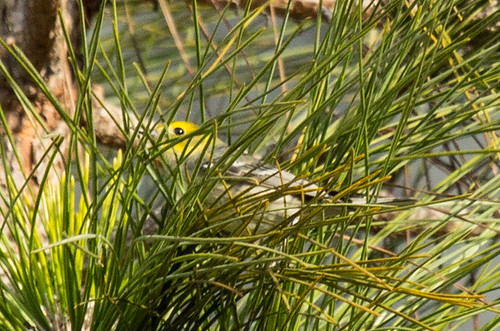 |
| Crappy photo of a Hermit Warbler--a target bird I specifically searched for three times before I finally saw. |
 |
| Anna's Hummingbird: One of the bonus birds I saw one of the times I was missing that Hermit Warbler. |
On my Big Year, I relished getting to spend days of intensive birding with a few close friends, such as Paula Lozano in Ohio, and Eric Bowman, Larry Foard, and Ali Sheehey in California. I also participated in a few birding festivals for which I was a speaker and so got to attend the field trips. I thoroughly enjoyed the Space Coast Birding Festival in Florida, the Red Slough Birding Festival in Oklahoma, the Biggest Week in American Birding in Ohio, the Rio Grand Valley birding festival in Texas, and the Monterey birding festival in California (I wasn't a speaker at the last two), and I took two guided tours with Kim Eckert, to Texas and Colorado. I was invited to be the keynote speaker at Kansas's Wings N Wetlands Birding Festival; when that was cancelled because of the drought, I still got to go and was taken around to great places by Curtis Wolf and Robert Penner. I spent a couple of weeks in Delaware, being escorted to splendid birding spots by Debra Chiczewski. To see a Bicknell's Thrush, I went on the auto tour up Mount Washington, so I wouldn't enter and risk disturbing more pristine habitat. I heard and saw Kirtland's Warblers on my own, knowing how to find them without going off roads (they're loud singers!), but I also went on the public tour to support the best way for anyone to add this splendid bird to their lifelist.
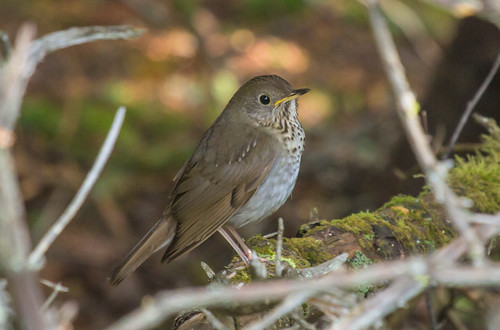 |
| Bicknell's Thrush seen on the Mt. Washington Auto Road tour. |
When I was headed to the Southwest, I learned that a Rufous-necked Wood-Rail had just been found at Bosque del Apache National Wildlife Refuge, so I made that my first stop. Hundreds of birders descended on the refuge for that first U.S. record bird, and since the only vantage point to see it was from a specific boardwalk, birders gathered with lawn chairs and cold drinks for what felt more like a social event than a birding jaunt. It was wonderful fun, and most of us got to see a really cool bird, to boot.
 |
| Rufous-necked Wood-Rail |
So I do enjoy all kinds of birding experiences. But on my Big Year, I was very pleased to see every species of North American warbler entirely on my own at least once, except for the MacGillivray's Warbler that I only saw one time, with Eric Bowman in Yosemite. That one we both picked out simultaneously, so we both earned it. It was fun to see a Swainson's Warbler—a North American lifer—with Mia Revels, the researcher who is the expert on the Oklahoma population, as well as hearing them and getting one quick glimpse entirely on my own. Spending time with experts and local authorities provides a wealth of information impossible to get entirely on our own, and can be darned fun as well.
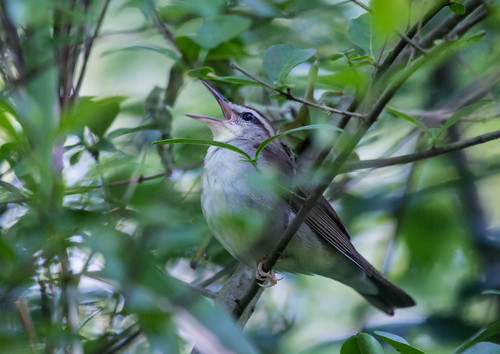 |
| Swainson's Warbler found by Mia Revels in Oklahoma. |
My friend Heidi Trudell told me exactly where to go to get my North American lifer Golden-cheeked Warbler at the Balcones Canyonlands National Wildlife Refuge. The birds were silent—I got there in late afternoon in mid-July—but it was thrilling to find them entirely on my own.
 |
| Golden-cheeked Warbler in Balcones Canyonlands. |
I sat on my good friend Susan Eaton's deck eating lunch while watching Eurasian Tree Sparrows in comfort at her feeders for my Big Year. So it's hardly that I object to easy birds or birding with pleasant company.
 |
| Eurasian Tree Sparrow in my friend Susan's backyard. |
I enjoy being a participant on birding tours, too. They allow us to see more species than what we could find on our own in an unfamiliar area, plus we don't need to drive or figure out logistics—that's all taken care of. But except when I’ve birded outside of the country, I’ve virtually always birded a new area on my own before going out on an organized tour—it makes me appreciate the leader’s added knowledge and local experience more, even as I recognize many of the birds from having figured out their habits in that habitat on my own.
But I'm really too much of an introvert to enjoy large group birding too often. And there is no way on earth I'd be good at actually leading an organized tour. I forget about food and am perfectly content to sleep in my car when I'm having fun birding. You can't hear a Flammulated Owl calling all night long from even the finest motel, while I got to do just that when sleeping in my car in Water Canyon in New Mexico. Normal people expect meals and a bed to sleep in and have other needs I just don't want to deal with. And I'm completely out of my element at explaining what expenses and responsibilities other people should take care of themselves when birding with me, so I'm easily taken advantage of as well.
I read a lot of posts by birding guides on Facebook, and am always impressed by how they can go out, day after day, week after week, showing each individual of each group a huge number of birds. They earn their pay with their skills, ability to juggle logistics, and unflagging focus and ability to keep moving on to the next bird while ensuring their participants all have a satisfying experience. It was fun for me to get out for one weekend for the first time in years to show someone around the north woods. But the experience reminded me that at heart, I really am an introverted moseyer.
Recently I discovered that a few bird guides and photographers up here have been publicly ridiculing me, claiming that all my knowledge comes from reading about birds rather than going out and actually experiencing them. That's hurtful, of course, as well as patently false, but I don't even know how to begin to answer that kind of silliness. Fortunately, most of the birders up here, like everywhere else, don't need to cut down anyone else to carve their own place in the birding world. As Robert Frost might have put it, birders work together, I tell you from the heart, whether we bird together or apart.
I can’t wait to get my new puppy. I’ll take Pip everywhere birding with me. I may have named her for a character in
Great Expectations, but the great thing about puppies is they don’t have any expectations. For her, our tracking down every pigeon and nuthatch will be an adventure, and when we don’t see the birds I want, she’ll be perfectly content with what we do find. That, for me, is what the funnest birding is all about.
 |
| My future little birding companion, Pip |












